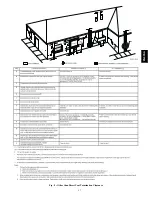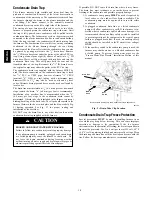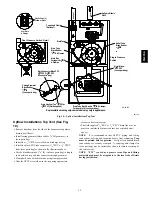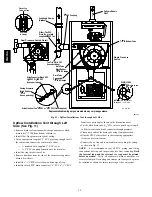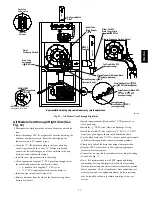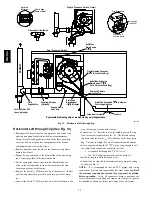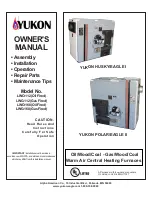
10
Minimum One Inlet and One Outlet Air Supply is Required
May be in any Combination Shown
Inlet Air Opening Must be Within12
″
of floor
Outlet Air Opening Must be Within12
″
of ceiling
(1) 1 Square Inch per 4000 BTUH
(2) 1 Square Inch per 2000 BTUH
This installation NOT approved in Canada
Gas Vent
Gable Vent
Ventilated Attic
Top Above Insulation
Alternate Inlet Air (1)
Ventilated Crawl Space
Outlet Air (1)
Soffit Vent
Outlet
Air (1)
Inlet
Air (1)
Outlet
Air (2)
Inlet
Air (2)
Gas Vent
Inlet
Air (2)
Soffit Vent
Gas Vent
Gable Vent
Ventilated Attic
Top Above Insulation
Inlet
Air (1)
OutletAir (1)
alternate Inlet Air (1)
A07704
Fig. 5 -- Outside Air
(This is ONLY a guide. Subject to codes of country having jurisdiction).
This furnace
MUST NOT
be installed directly on carpeting or
tile or other combustible material other than wood flooring or
supports.
For horizontal installation over a finished living space. A field
fabricated auxiliary drain pan with drain pipe is required to
prevent damage by overflow due to blocked condensate drain.
COMBUSTION & VENTILATION AIR
For Single Pipe Installation
CARBON MONOXIDE POISONING HAZARD
Failure to follow this warning could result in personal injury or
death.
Use methods described here to provide combustion and
ventilation air.
!
WARNING
Furnaces require ventilation openings to provide sufficient air for
proper combustion and ventilation of flue gases. All duct or
openings for supplying combustion and ventilation air must
comply with the gas codes, or in the absence of local codes, the
applicable national codes.
Combustion and ventilation air must be supplied in accordance
with one of the following:
NOTE
:
The Combustion & Ventilation Air Section in this
document, uses tables and information from the ANSI
Z223.1/NFPA 54. For use in Canada, use CSA B149.1 for this
information.
1. Section 9.3, Air for Combustion and Ventilation, of the
National
Fuel
Gas
Code,
(NFGC),
ANSI
Z223.1--2006/NFPA 54--2006 in the U.S.,
2. Sections 8.2, 8.3, 8.5, 8.6, 8.7, and 8.8 of National Stand-
ard of Canada, Natural Gas and Propane Installation Code
(NSCNGPIC), CSA B149.1--05 in Canada,
3. Applicable provisions of the local building code.
This furnace can NOT be common vented or connected to any
type B, BW or L vent or vent connector, nor to any portion of a
factory--built or masonry chimney. Multistory venting is NOT
permitted.
If
this
furnace
is
replacing
a
previously
common-vented furnace, it may be necessary to resize the
existing vent and chimney to prevent oversizing problems for the
other remaining appliance(s). See
“Venting and Combustion Air
Check”
in this section
.
This furnace MUST be vented to the
outside.
When the installation is complete, check that all appliances have
adequate combustion air and are venting properly. See
Venting
And Combustion Air Check
in “
Gas Vent Installation”
Section in
this manual.
Outdoor Combustion Air Method
A space having less than 50 cubic feet per 1,000 BTUH input
rating for all gas appliances installed in the space requires
outdoor air for combustion and ventilation.
Air Openings and Connecting Ducts
1. Total input rating for all gas appliances in the space
MUST
be considered when determining free area of open-
ings.
2. Connect ducts or openings directly to the outdoors.
3. When screens are used to cover openings, the openings
MUST
be no smaller than
1
/
4
″
(6.35 mm) mesh.
4. The minimum dimension of air ducts
MUST NOT
be less
than 3
″
.
5. When sizing a grille, louver, or screen use the free area of
opening. If free area is
NOT
stamped or marked on grill or
louver, assume a 20% free area for wood and 60% for met-
al. Screens shall have a mesh size not smaller than
1
/
4
″
(6.35 mm) .
Confined Space Installation
NOTE
: A confined space is defined as an area with less than 50
cubic feet per 1,000 BTUH input rating for all gas appliances
installed in the area.
Requirements
1. Provide the space with sufficient air for proper combustion
and ventilation of flue gases using horizontal or vertical
ducts or openings.
PG9Y
AA

















